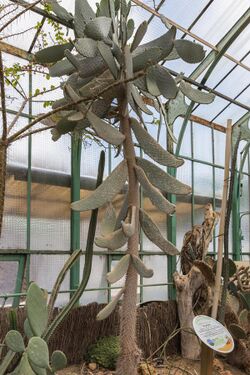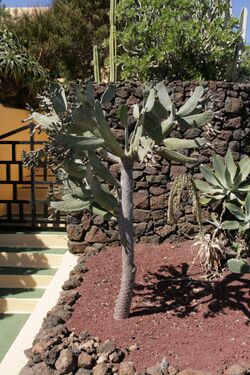Biology:Consolea moniliformis
| Consolea moniliformis | |
|---|---|

| |
| Scientific classification | |
| Kingdom: | Plantae |
| Clade: | Tracheophytes |
| Clade: | Angiosperms |
| Clade: | Eudicots |
| Order: | Caryophyllales |
| Family: | Cactaceae |
| Genus: | Consolea |
| Species: | C. moniliformis
|
| Binomial name | |
| Consolea moniliformis (L.) A.Berger, 1926
| |
| Synonyms[2] | |
|
List
| |
Consolea moniliformis is a species of cactus that is native to the Greater Antilles, on Cuba, Hispaniola (in the Dominican Republic and Haiti), and Puerto Rico (on the islands of Mona, Culebra and Desecheo).[3]
Names
Common names include:[4]
- English: necklacelike pricklypear
- French: Opuntia patte-de-tortue, patte de tortue, patte tortue, raquette espagnole (Haiti)
- Spanish: alpargata (Dominican Republic), tuna (Puerto Rico)
- Haitian Creole: pat tôti, rakèt panyôl
Distribution and habitat
Consolea moniliformis can be found at elevations from sea level to about 50 metres.
In Cuba, it occurs in dry littoral forest, as well as limestone. In the city of Santiago de Cuba it is cultivated in gardens.
In Puerto Rico, it occurs in open dry forests and is sparsely distributed, but occurs abundantly.
On Hispaniola, the species is common in Hispaniolan dry forests.
Description
It is a tree-like cactus species to 4(-7) m height, freely branching in the crowns. In this species, as in a few other opuntias, the fruits are quite proliferous, often in long chains of 2-5 (or more) individuals or forming compound clusters. They hang on for a number of years and usually remaining green. They are, however, easily detached, and, when falling to the ground, they readily take root and start new colonies.[3]
Conservation
Its population is male-biased throughout the range. It is unknown whether there is seedling recruitment in the wild. Damage from the invasive moth Cactoblastis cactorum was not recorded in Dominican populations, but moderately present in Puerto Rican populations. Deforestation in Haiti has led to the suspicion of its extirpation there. Despite these threats, the species is considered Least Concern by the IUCN Red List.
References
- ↑ Negrón-Ortiz, V.; Griffith, P.; Taylor, N.P.; González Torres, L.R.; Barrios, D. (2017). "Consolea moniliformis". IUCN Red List of Threatened Species 2017: e.T151754A121442124. doi:10.2305/IUCN.UK.2017-3.RLTS.T151754A121442124.en. https://www.iucnredlist.org/species/151754/121442124. Retrieved 20 November 2021.
- ↑ "Consolea moniliformis (L.) A.Berger". The Trustees of the Royal Botanic Gardens, Kew. n.d.. https://powo.science.kew.org/taxon/urn:lsid:ipni.org:names:64446-2.
- ↑ 3.0 3.1 "Consolea moniliformis (L.) A.Berger". Encyclopedia of Living Forms. n.d.. http://www.llifle.com/Encyclopedia/CACTI/Family/Cactaceae/9726/Consolea_moniliformis.
- ↑ Grandtner, Miroslav M. (2005). Elsevier's Dictionary of Trees - North America. Amsterdam: Elsevier. p. 594. ISBN 9780080460185. https://books.google.com/books?id=yjc5ZYWtkNAC&q=consolea+moniliformis.
Bibliography
- Forest & Kim Starr.. Plants of Hawaii. http://www.starrenvironmental.com/images/.
- Grandtner, M. M. (2005). Elsevier's Dictionary of Trees. Amsterdam: Elsevier. ISBN 0-444-51784-7.
- Liogier, Alain H. (1994). Descriptive Flora of Puerto Rico and Adjacent Islands: Spermatophyta. Cyrillaceae to Myrtaceae. Puerto rico: Editorial de la Universidad de Puerto Rico. ISBN 0-8477-2333-X.
Wikidata ☰ Q1127465 entry
 |



